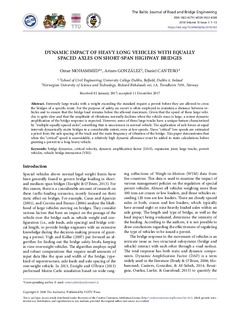| dc.contributor.author | Mohammed, Omar | |
| dc.contributor.author | Gonzalez, Arturo | |
| dc.contributor.author | Cantero, Daniel | |
| dc.date.accessioned | 2019-02-12T09:29:29Z | |
| dc.date.available | 2019-02-12T09:29:29Z | |
| dc.date.created | 2018-03-29T19:05:00Z | |
| dc.date.issued | 2018 | |
| dc.identifier.citation | Baltic Journal of Road and Bridge Engineering. 2018, 13 (1), 1-13. | nb_NO |
| dc.identifier.issn | 1822-427X | |
| dc.identifier.uri | http://hdl.handle.net/11250/2584955 | |
| dc.description.abstract | Extremely large trucks with a weight exceeding the standard require a permit before they are allowed to cross the bridges of a specific route. For the purpose of safety, an escort is often employed to maintain a distance between ve-hicles and to ensure that the bridge load remains below the allowed maximum. Given that the speed of these large vehi-cles is quite slow and that the amplitude of vibrations normally declines when the vehicle mass is large, a minor dynamic amplification of the bridge response is expected. However, some of these large trucks have a unique feature characterized by “multiple equally-spaced axles”, something that is uncommon in normal vehicle. The application of axle forces at equal intervals dynamically excite bridges to a considerable extent, even at low speeds. These “critical” low speeds are estimated a priori from the axle spacing of the truck and the main frequency of vibration of the bridge. This paper demonstrates that when the “critical” speed is unavoidable, a relatively high dynamic allowance must be added to static calculations before granting a permit to a long heavy vehicle. | nb_NO |
| dc.language.iso | eng | nb_NO |
| dc.publisher | Vilniaus Gedimino Technikos Universitetas | nb_NO |
| dc.rights | Navngivelse 4.0 Internasjonal | * |
| dc.rights.uri | http://creativecommons.org/licenses/by/4.0/deed.no | * |
| dc.title | Dynamic impact of heavy long vehicles with equally spaced axles on short-span highway bridges | nb_NO |
| dc.title.alternative | Dynamic impact of heavy long vehicles with equally spaced axles on short-span highway bridges | nb_NO |
| dc.type | Journal article | nb_NO |
| dc.type | Peer reviewed | nb_NO |
| dc.description.version | publishedVersion | nb_NO |
| dc.source.pagenumber | 1-13 | nb_NO |
| dc.source.volume | 13 | nb_NO |
| dc.source.journal | Baltic Journal of Road and Bridge Engineering | nb_NO |
| dc.source.issue | 1 | nb_NO |
| dc.identifier.doi | 10.3846/bjrbe.2018.382 | |
| dc.identifier.cristin | 1576261 | |
| dc.description.localcode | Copyright © 2018 The Author(s). Published by VGTU PressThis is an Open Access article distributed under the terms of the Creative Commons Attribution License (http://creativecommons.org/licenses/by/4.0/), which permits unre-stricted use, distribution, and reproduction in any medium, provided the original author and source are credited. | nb_NO |
| cristin.unitcode | 194,64,45,0 | |
| cristin.unitname | Institutt for konstruksjonsteknikk | |
| cristin.ispublished | true | |
| cristin.fulltext | postprint | |
| cristin.qualitycode | 1 | |

